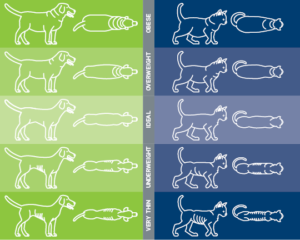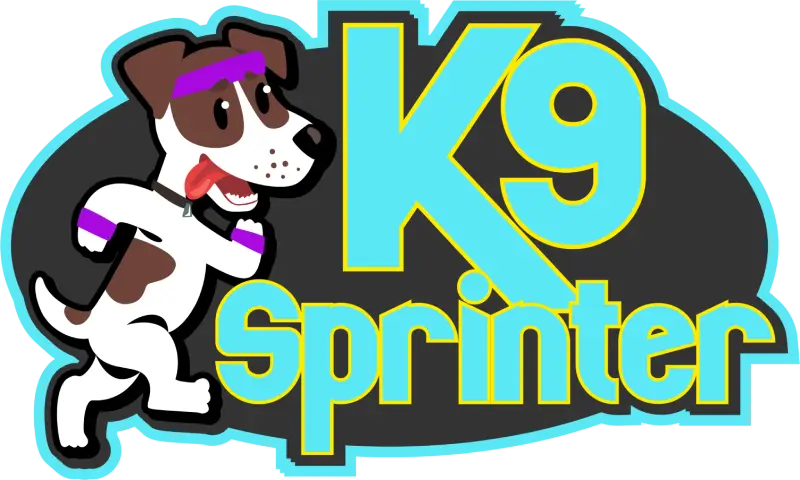As the pet owners weight fluctuates, your pets weight fluctuates as well. The way veterinarians determine if your pet is overweight is on a scale of one to nine (1-9)…where one (1) is underweight and nine (9) is obese. Its important to note that some veterinarians in the United States assign obesity on a one (1) to five (5) scale but 1-9 is the most accurate “measurement” for better accuracy. How do we determine if your pet is overweight? The scale of one (1) to nine (9) is not as accurate as we determine weight characteristics in humans. We determine if humans are underweight, average, or overweight according to Body Mass Index (BMI).
BMI (Body Mass Index) is determined by a persons body mass divided by the square of their height according to National Heart, Lung, and Blood Institute .
Note: The BMI calculator uses Centimeters and Kilograms. Please click the links provided to easily convert from Inches to Centimeters and Pounds to Kilograms.
BMI is a formula and is very accurate but veterinarians do not characterize if a pet is underweight, average, or overweight based on a BMI scale.
Obesity in dogs and cats is based on 30% of ideal weights. Once a pet reaches 30% or more above their ideal weight veterinarians begin to see changes in metabolic function, organ function, and decrease in lifespan.

It is important to recognize just like every human is different, every pet is different. Everyone will loose or gain weight from different places on their body. It is important to focus on not how much your pet is overweight or how much they need to loose but that they are loosing weight. Focus on small victories than the overall goal. Some small victories may include: walking up stairs, getting out of the car, or going for longer walks on a treadmill.
It is important to recognize that your pet is overweight so that implementations can be put in place to bring them back to a healthy weight. There are many ways to have your pet loose weight. Implementing many actions will set your pet up for success. Some ways include:
- Arranging for someone else to exercise the pet when the owner is unable to do so
- Ensure others in the home understand the healthy weight goals for the pet
- Measure the correct amount of food and caloric intake requirements for your pet(s) specific energy requirements
- Follow feeding guidelines of a specific diet, amount, and frequency
At K9 Sprinter we use treadmills also known as “slat mills”. Slat mills got their name from how the walking surface is made up of pieces or slats. The slats are linked together to form a uniform walking surface for your pet to exercise. Our slat mills have many safety features, one of which is side walls. Dogs use the side walls to walk in a straight line by utilizing her peripheral vision. The side walls are also there to keep you pet safe while they learn to balance. Our slat mills allow pet hair, drool, or bodily functions to move freely. Our slat mills do not have a motor; your pet can walk, trot, or run at their pace. When your pet gets tired, they can slow down or stop. A K9 Sprinter team member is always there 100% of the time to make sure your pet is having fun, enjoying their exercise, and most importantly staying safe!
Some of the other safety features of our slat mills are how the track is designed, the riser, and harnesses. The track has a lightly textured surface which limits slipping. Each slat is cushioned, the cushioned slats provide stability while also giving some flexibility for your dogs joints. Also, as mentioned above, the slats are completely enclosed and uniform. The slats are enclosed on the ends, this prevents any moving parts from hurting your dog and preventing your dogs nails or pads from getting caught. The riser, or the vertical harm, on the slat mill can be moved forward and aft to put your dog in the most comfortable and stable position on the slat mill. Lastly, we only use harnesses while your dog is on the slat mill. The harnesses we use give your dog a stabile contact point to run and do not damage any internal organs.
Using a treadmill designed for humans can be hazardous to your pet. Human treadmills do not have any side wall protection and the other safety features our slat mills provide, they also can get clogged with pet hair, drool or bodily fluids that can damage the inner workings and motor. Treadmills designed for humans also have a motor, which forces your pet to walk.
Visit our Youtube channel to see all the dogs exercising or watch our video to learn more about all of the design functions and safety features we implement to keep you pup safe. As always if you have questions or would like to see our slat mills in person please call (507) 405-4345 or visit our booking page.
*Please consult your veterinarian if you suspect your pet is overweight and what the best corse of action might be for them.
Calculate your body mass index. (n.d.). National Heart, Lung, and Blood Institute. Retrieved March 20, 2022, from https://www.nhlbi.nih.gov/health/educational/lose_wt/BMI/bmicalc.htm
Your pet’s healthy weight. (n.d.). American Veterinary Medical Association. Retrieved March 20, 2022, from https://www.avma.org/resources/pet-owners/petcare/your-pets-healthy-weight
Taking on obesity as a disease. (2018, September 12). American Veterinary Medical Association. https://www.avma.org/javma-news/2018-10-01/taking-obesity-disease
